What is a Stakeholder Map? A Complete Guide with Examples
Welcome to this insightful exploration of the concept of a Stakeholder Map. Effective stakeholder management is a fundamental driver of success in today's complex business landscape. Understanding who your stakeholders are, their interests, influence, and expectations can make or break a project or organisation. That's where a Stakeholder Map comes into play.
A Stakeholder Map is a powerful strategic tool in project management, business analysis, and organisational planning. It offers a structured approach to identify, categorise, and visualise the various stakeholders involved in a project or initiative. By plotting stakeholders based on their levels of interest and influence, this map provides a clear overview, helping decision-makers prioritise engagement efforts, manage risks, and tailor communication strategies.
In this guide, we'll delve into the components, benefits, and steps involved in creating an effective Stakeholder Map, shedding light on how this tool can drive success in a myriad of endeavours. Let's embark on this journey to harness the power of stakeholder mapping.
What is a Stakeholder Map?
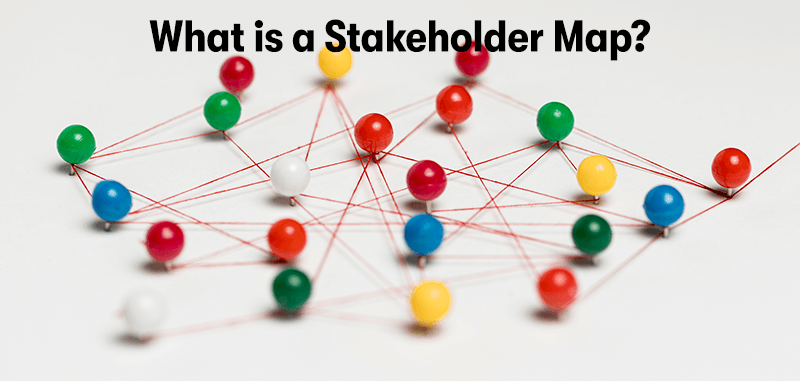
A Stakeholder Map is a visual representation or tool used in project management, business analysis, or strategic planning to identify and categorise the various stakeholders involved in a project, initiative, or organisation. Stakeholders are individuals, groups, or entities with an interest, influence, or stake in the outcomes or success of the project or organisation. These stakeholders include employees, customers, suppliers, regulatory bodies, investors, and more. The primary purpose of creating a Stakeholder Map is to:
Identify Stakeholders
The map helps in systematically identifying all relevant stakeholders, ensuring that no important parties are overlooked.
Categorise Stakeholders
Stakeholders can be categorised based on their level of interest and influence on the project or organisation. Common categories include "high interest, high influence," "low interest, high influence," "high interest, low influence," and "low interest, low influence."
Prioritise Stakeholder Engagement
By understanding each stakeholder's level of interest and influence, organisations can prioritise their efforts in engaging and communicating with them. High-influence stakeholders with a high level of interest typically require more attention and communication.
Mitigate Risks
Identifying stakeholders' concerns early in the project or planning process can help proactively address potential issues or conflicts.
Stakeholder Maps are often created in the form of a matrix or a visual diagram, with stakeholders listed along one axis (typically the rows) and their level of interest and influence plotted along the other axis (usually the columns). The resulting grid allows project managers and teams to see which stakeholders are most critical and how they should be managed throughout the project lifecycle.
Effective stakeholder management is crucial for project success and achieving organisational goals, as it ensures that the interests and concerns of all relevant parties are considered and addressed appropriately.
What Are Stakeholders?

Stakeholders are individuals, groups, or entities with an interest, concern, or stake in a particular project, organisation, or initiative. They can be internal or external to the project or organisation and have various levels of influence and importance. Stakeholders play a crucial role in shaping the project's outcomes and success or the organisation's overall direction. Here are some common categories of stakeholders:
Internal Stakeholders
Employees: People working within the organisation who are directly or indirectly impacted by its decisions and outcomes.
Management and Leadership: Executives, managers, and leaders within the organisation who make key decisions and set strategic direction.
Shareholders/Owners: Individuals or entities who own shares or have a financial stake in the organisation.
Board of Directors: A governing body responsible for overseeing the organisation's strategic decisions.
External Stakeholders
Customers: Individuals or entities who purchase and use the organisation's products or services.
Suppliers: Companies or individuals who provide goods, services, or resources to the organisation.
Partners and Collaborators: Other organisations or entities that collaborate with the organisation to achieve common goals.
Government and Regulatory Bodies: Government agencies or regulatory authorities that may impose rules, regulations, or policies affecting the organisation.
Community and Society: The local community, society at large, or specific interest groups that can be impacted by or have an interest in the organisation's actions.
Special Interest Groups
These can include advocacy groups, environmental organisations, labour unions, or any group that advocates for specific causes and may have a vested interest in the organisation's activities.
Competitors
The organisation's actions may affect rival organisations or companies in the same industry.
Stakeholders can have varying degrees of influence and interest in the project or organisation. Managing and engaging with stakeholders effectively is essential for achieving project success and maintaining a positive relationship with those who can impact or are impacted by the project's outcomes. It involves understanding their needs, concerns, and expectations, as well as communicating with them, involving them in decision-making when appropriate, and addressing any conflicts or issues that may arise during the project or organisational activities. Stakeholder management is critical to project management, business strategy, and corporate governance.
Why are Stakeholder Maps Important for Businesses?
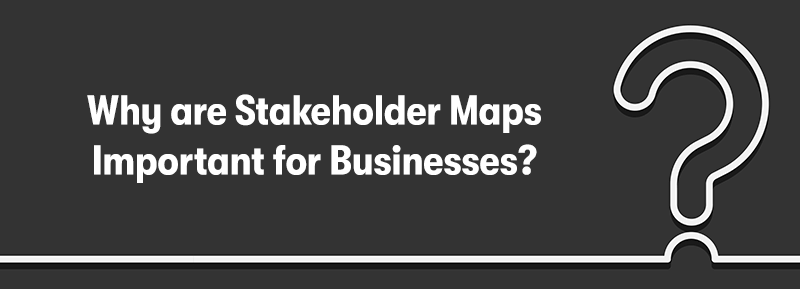
Stakeholder maps are important for businesses for several reasons, as they provide a structured and visual way to understand, categorise, and manage the various stakeholders involved in a business's operations. Here are some key reasons why stakeholder maps are crucial for businesses:
Identify and Prioritise Stakeholders
Stakeholder maps help businesses identify all relevant stakeholders, ensuring no important parties are overlooked. By categorising stakeholders based on their level of interest and influence, businesses can prioritise their efforts in engaging and communicating with them. This helps allocate resources and attention more effectively, focusing on the stakeholders with the greatest impact on the business.
Risk Mitigation
Understanding and mapping stakeholders early in the business planning process can help proactively identify potential risks and issues. By recognising the concerns and interests of different stakeholders, businesses can take steps to mitigate risks, address conflicts, and prevent negative outcomes. This proactive approach can save time and resources in the long run.
Strategic Decision-Making
Stakeholder maps provide valuable insights for strategic decision-making. Businesses can use this information to align their strategies with the expectations and needs of key stakeholders. It helps in making informed choices that are more likely to be accepted and supported by those who matter most to the business's success.
Effective Communication
Knowing who the stakeholders are and what they care about allows businesses to tailor their communication strategies. Different stakeholders may require different messaging and channels of communication. Stakeholder maps enable businesses to craft messages that resonate with their target audiences, enhancing the effectiveness of communication efforts.
Relationship Management
Building and maintaining positive relationships with stakeholders is essential for long-term success. Stakeholder maps facilitate relationship management by clearly understanding each stakeholder's perspective, concerns, and expectations. Businesses can engage with stakeholders in a way that fosters trust and collaboration.
Compliance and Regulation
In regulated industries, stakeholder maps can help businesses ensure compliance with relevant laws, regulations, and standards. Businesses can avoid legal issues and penalties by identifying regulatory bodies and understanding their requirements.
Innovation and Opportunity Identification
Stakeholder maps can also be a source of innovation and opportunity. By engaging with stakeholders, businesses may discover new ideas, partnerships, or market opportunities they hadn't considered previously. Engaging with stakeholders can lead to creative solutions and strategic insights.
Reputation Management
Stakeholders can significantly impact a business's reputation. Effective stakeholder management, facilitated by stakeholder maps, can help businesses protect and enhance their reputation by addressing concerns, demonstrating social responsibility, and aligning with stakeholder values.
In summary, stakeholder maps are a valuable tool for businesses to navigate complex stakeholder landscapes, make informed decisions, manage risks, and foster positive relationships. They are an essential component of strategic planning, project management, and overall business success.
What is a Stakeholder Map Matrix?
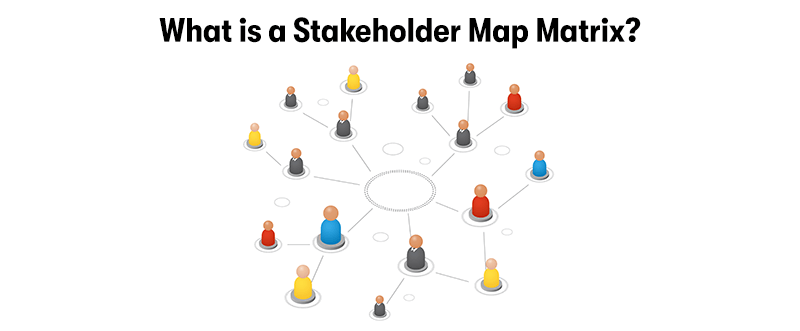
A Stakeholder Map Matrix, also known as a Stakeholder Matrix or Stakeholder Engagement Matrix, is a structured tool used to categorise and analyse stakeholders based on their level of interest and influence in a project, initiative, or organisation. This matrix is typically presented in a tabular format with stakeholders listed in rows and their levels of interest and influence assessed and documented in columns. It helps project managers, business analysts, and decision-makers understand the relative importance of each stakeholder and plan how to engage with them effectively. Here are the two main dimensions commonly used in a Stakeholder Map Matrix:
Interest
This dimension measures how much a stakeholder is affected by or interested in the project, initiative, or organisation's outcomes. Stakeholders with high interest have a significant concern or stake in the project's success or its impact on them.
Influence
This dimension assesses the level of influence or power that a stakeholder holds over the project or organisation. Stakeholders with high influence can shape decisions, allocate resources, or affect the project's direction.
The matrix is usually divided into four quadrants, each representing a different category of stakeholders based on their combination of interest and influence:
1. High Interest, High Influence
These are the most critical stakeholders. They have a strong interest in the project's success and the ability to influence its direction. Engaging and collaborating closely with these stakeholders is essential to ensure their needs and concerns are addressed.
2. High Interest, Low Influence
Stakeholders in this category are deeply interested in the project's outcomes but have limited influence over its execution. While they may not have direct decision-making power, keeping them informed and managing their expectations is still important to prevent potential issues.
3. Low Interest, High Influence
These stakeholders have significant influence over the project or organisation but may not be particularly interested in or affected by it. Maintaining a basic level of communication and engagement is essential to keep them informed and satisfied.
4. Low Interest, Low Influence
Stakeholders in this category have neither a strong interest in the project nor significant influence over it. They typically require minimal attention, and resources can be allocated more sparingly when dealing with them.
Project managers and teams can develop tailored communication and engagement strategies for each group by plotting stakeholders on the matrix. High-priority stakeholders (those in the high-interest, high-influence quadrant) may require regular meetings, involvement in decision-making, and detailed updates. In contrast, stakeholders in the low-interest, low-influence quadrant may only need occasional updates or minimal engagement.
The Stakeholder Map Matrix is a valuable tool for effective stakeholder management, risk mitigation, and decision-making, as it helps organisations allocate resources and efforts strategically based on the relative importance of different stakeholders.
What is a Stakeholder Map Template?
A Stakeholder Map Template is a pre-designed or customisable format that provides a structured framework for creating a Stakeholder Map or Stakeholder Matrix. It serves as a starting point for individuals or organisations to document and visualise their stakeholders, their levels of interest and influence, and other relevant information. Stakeholder Map Templates are often used in project management, business analysis, and strategic planning to streamline the process of stakeholder analysis and engagement planning. Here are the key elements typically included in a Stakeholder Map Template:
| Element | Description |
| Stakeholder List | A section to list the names or titles of all relevant stakeholders involved in the project, initiative, or organisation. This list can be organised in rows or columns. |
| Interest Dimension | A column or row where stakeholders' levels of interest are assessed and indicated, usually using descriptive terms like "high," "medium," or "low." |
| Influence Dimension | A column or row where stakeholders' levels of influence or power are assessed and indicated, often using terms like "high," "medium," or "low." |
| Quadrant Placement | A graphical representation of stakeholders' positions on the Stakeholder Map Matrix, showing which quadrant they belong to based on their assessed interest and influence. |
| Key Information | Space to include additional information about each stakeholder, such as their role, department, contact details, and specific concerns or expectations. |
| Engagement Strategy | A section outlining each stakeholder group's engagement and communication strategies based on their position in the matrix. |
| Notes or Comments | A space for capturing any additional notes, comments, or insights related to specific stakeholders or the stakeholder analysis process. |
Stakeholder Map Templates can come in various formats, including spreadsheets, documents, presentation slides, or specialised software tools. They are designed to save time and ensure consistency when conducting stakeholder analysis. Organisations can customise these templates to align with their specific needs, terminology, and project requirements.
Using a Stakeholder Map Template can help teams and individuals:
- Systematically identify and document all relevant stakeholders.
- Assess and visualise the relative importance of each stakeholder.
- Develop tailored communication and engagement strategies for different stakeholder groups.
- Collaborate and share stakeholder information with project teams and decision-makers.
- Monitor and update stakeholder engagement plans as the project or initiative progresses.
Many project management software tools and templates are available online or as part of project management software suites, making it easier for businesses and organisations to create and manage stakeholder maps efficiently.
Some Stakeholder Map Examples
Here are some simplified Stakeholder Map examples to help illustrate how stakeholders can be categorised based on their levels of interest and influence:
Example 1: Construction Project
High Interest, High Influence: Project Sponsor, Local Government
High Interest, Low Influence: Nearby Residents, Environmental Groups
Low Interest, High Influence: Contractors, Suppliers
Low Interest, Low Influence: General Public, Distant Businesses
In this example, the project sponsor and local government have both a high interest in the construction project's success and the ability to influence its direction. Nearby residents are highly interested but have limited influence. Contractors and suppliers may not be very interested but have a significant influence due to their roles. The general public and distant businesses have minimal interest and influence.
Example 2: Product Launch
High Interest, High Influence: CEO, Key Investors
High Interest, Low Influence: Marketing Team, Customer Advisory Board
Low Interest, High Influence: Manufacturing Team, Legal Department
Low Interest, Low Influence: General Employees, Vendors
In this scenario, the CEO and key investors have both a strong interest in the product launch's success and the ability to influence its direction. The marketing team and customer advisory board are highly interested but may have limited influence over the launch strategy. The manufacturing team and legal department have significant influence but may not be as invested in the launch's success. General employees and vendors have minimal interest and influence.
Example 3: Non-profit Organisation
High Interest, High Influence: Major Donors, Board of Directors
High Interest, Low Influence: Volunteers, Beneficiaries
Low Interest, High Influence: Legal Counsel, Government Funders
Low Interest, Low Influence: General Public, Media
In this non-profit organisation example, major donors and the board of directors have both a high interest in the organisation's success and the ability to influence its decisions. Volunteers and beneficiaries are highly interested but may have limited influence. Legal counsel and government funders have significant influence but may not be as deeply invested. The general public and media have minimal interest and influence in day-to-day operations.
These examples demonstrate how stakeholders can be categorised into quadrants based on their levels of interest and influence. However, the specific stakeholders and their positions on the map may vary widely depending on the context and the project or organisation's unique circumstances. Stakeholder maps are most effective when customised to fit the specific needs and goals of the project or initiative being analysed.
What Are the Four Steps When Building a Stakeholder Map?
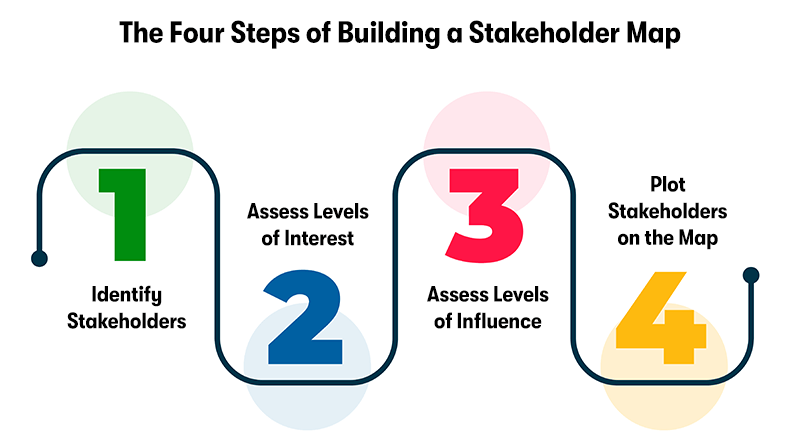
Building a stakeholder map involves several steps to systematically identify, categorise, and analyse stakeholders based on their interest levels and influence in a project, initiative, or organisation. Here are the four main steps to follow when creating a stakeholder map:
Identify Stakeholders
The first step is compiling a comprehensive list of all potential stakeholders relevant to the project, initiative, or organisation. This involves brainstorming and researching to ensure that no important parties are overlooked.
Stakeholders can be internal or external to the organisation, including individuals, groups, or entities with varying degrees of interest and influence.
Assess Levels of Interest
Once the list of stakeholders is compiled, assessed, and categorised their interest levels in the project or organisation. Interest can be gauged by considering factors such as how much the stakeholder is affected by the outcomes or how invested they are in the project's success.
Stakeholders can be categorised as having "high," "medium," or "low" levels of interest.
Assess Levels of Influence
Simultaneously, assess and categorise stakeholders' levels of influence or power over the project, initiative, or organisation. Influence can be determined by considering the stakeholder's ability to shape decisions, allocate resources, or affect the project's direction.
Stakeholders can be categorised as having "high," "medium," or "low" levels of influence.
Plot Stakeholders on the Map
Use a Stakeholder Map Matrix (commonly a 2x2 grid) or a similar visual representation to plot stakeholders based on their assessed levels of interest and influence.
The resulting four quadrants in the map will categorise stakeholders as follows:
- High Interest, High Influence: Critical stakeholders who require close engagement and collaboration.
- High Interest, Low Influence: Stakeholders who need to be kept informed and satisfied.
- Low Interest, High Influence: Stakeholders who should be monitored and engaged as necessary.
- Low Interest, Low Influence: Stakeholders who require minimal attention.
Remember that stakeholder mapping is not a one-time task; it should be an ongoing process, as circumstances and stakeholder dynamics may change over time. Regularly reviewing and updating the stakeholder map ensures that engagement strategies remain relevant and effective throughout the project or organisational lifecycle.
By following these four steps, organisations can clearly understand their stakeholders, prioritise their engagement efforts, and make informed decisions that consider the needs and expectations of those who have a stake in their activities.
What are the Basic Components of a Stakeholder Map?
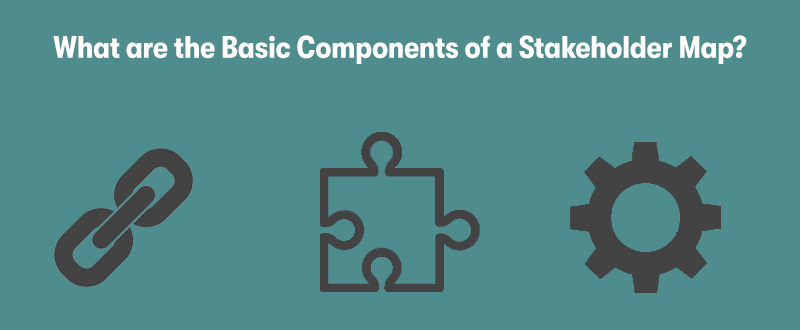
A Stakeholder Map typically consists of several basic components that provide a structured representation of the stakeholders and their characteristics. These components help project managers, business analysts, and decision-makers understand each stakeholder's relative importance and attributes. Here are the basic components of a Stakeholder Map:
Stakeholder List
A comprehensive list of all relevant stakeholders involved in the project, initiative, or organisation. This list includes the names or titles of individuals, groups, or entities with a stake or interest in the outcomes.
Interest Assessment
An evaluation of each stakeholder's level of interest in the project, initiative, or organisation. Interest can be categorised as "high," "medium," or "low," indicating how much the stakeholder is affected by or invested in the success of the endeavour.
Influence Assessment
An evaluation of each stakeholder's level of influence or power over the project, initiative, or organisation. Influence can also be categorised as "high," "medium," or "low," indicating the stakeholder's ability to shape decisions, allocate resources, or impact the direction of the project.
Stakeholder Positioning
A graphical representation of stakeholders' positions on a Stakeholder Map Matrix divides stakeholders into four quadrants based on their assessed interest and influence. The quadrants are typically labelled as:
- High Interest, High Influence
- High Interest, Low Influence
- Low Interest, High Influence
- Low Interest, Low Influence
Key Information
Space to include additional details about each stakeholder, such as their role, department, contact information, and specific concerns or expectations related to the project or organisation.
Engagement Strategy
A section outlining the strategies and tactics for engaging with each stakeholder group based on their position in the matrix. This may include communication plans, frequency of interactions, and specific engagement objectives.
Notes or Comments
An area for capturing any additional notes, comments, or insights related to specific stakeholders or the stakeholder analysis process. This can be helpful for documenting important discussions or considerations.
The combination of these components in a Stakeholder Map provides a visual and structured representation of the stakeholders and their characteristics, making it easier for organisations to prioritise engagement efforts, communicate effectively, and manage stakeholder relationships throughout the project or organisational lifecycle. The map can be created using various tools, such as spreadsheets, documents, or specialised software, and can be customised to suit the specific needs and goals of the analysis.
How Does Stakeholder Mapping Affect Sustainability?
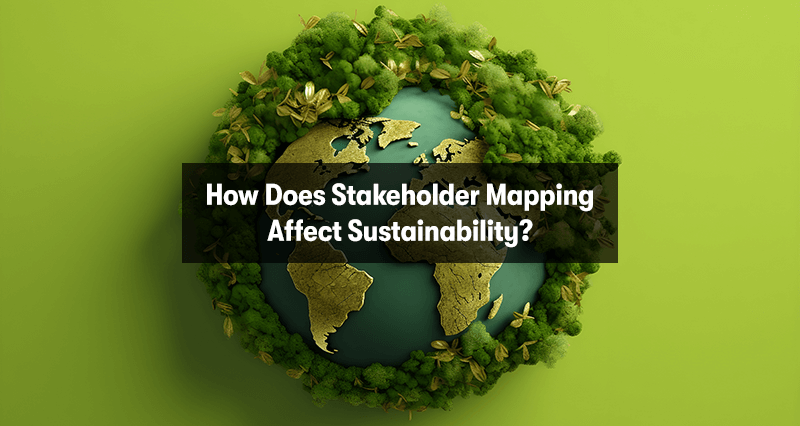
Stakeholder mapping can significantly impact sustainability efforts within organisations and projects. Sustainability, which encompasses environmental, social, and economic considerations, often involves complex and interconnected issues that affect various stakeholders. Here's how stakeholder mapping affects sustainability:
Identification of Key Stakeholders
Stakeholder mapping helps identify the key stakeholders who are most directly impacted by sustainability initiatives. These stakeholders may include local communities, environmental groups, regulatory bodies, suppliers, customers, and employees. Understanding who these stakeholders are is essential for effective sustainability planning.
Assessment of Interests and Influence
Stakeholder mapping allows organisations to assess key stakeholders' interests and influence levels regarding sustainability issues. This assessment helps prioritise which stakeholders to engage with more intensively and which may require less attention. For example, stakeholders with high influence and a strong interest in sustainability should be engaged closely to gain their support.
Enhanced Engagement Strategies
With a clear understanding of stakeholders' interests and influence, organisations can tailor their sustainability communication and engagement strategies. Stakeholder mapping helps craft messages and initiatives that resonate with different stakeholder groups, improving their chances of gaining support and cooperation.
Risk Mitigation
Identifying stakeholders who are concerned about sustainability issues or have the potential to influence regulatory decisions is crucial for mitigating sustainability-related risks. Engaging with these stakeholders early can help address their concerns, prevent negative impacts on the project, and avoid reputational damage.
Collaborative Approaches
Stakeholder mapping encourages collaboration with stakeholders who share sustainability goals. Organisations can work together with like-minded stakeholders to develop and implement sustainability strategies, share resources, and amplify the positive impact of their initiatives.
Innovation and Opportunity Identification
Organisations may uncover new opportunities and innovative solutions for sustainability challenges through stakeholder engagement. Stakeholders can provide valuable insights, ideas, and expertise that lead to more effective sustainability practices and initiatives.
Transparency and Accountability
Engaging with stakeholders and openly sharing sustainability progress builds transparency and accountability. Organisations that involve stakeholders in sustainability reporting and decision-making demonstrate their commitment to responsible and ethical practices.
Long-term Sustainability Planning
Stakeholder mapping can inform long-term sustainability planning by identifying evolving stakeholder interests and concerns. Organisations can adapt their strategies as stakeholder dynamics change to remain responsive to stakeholder needs.
Legitimacy and Reputation
Engaging with stakeholders and addressing their sustainability concerns can enhance an organisation's legitimacy and reputation. It demonstrates a commitment to responsible business practices and can positively impact how stakeholders and the public perceive the organisation.
In summary, stakeholder mapping plays a crucial role in sustainability efforts by providing a structured approach to understanding and engaging with stakeholders. It helps organisations prioritise their sustainability initiatives, manage risks, seize opportunities, and build stronger relationships with stakeholders with a vested interest in sustainability outcomes. Ultimately, effective stakeholder mapping contributes to the success and impact of sustainability initiatives within organisations and projects.
What is Digital Sustainability?
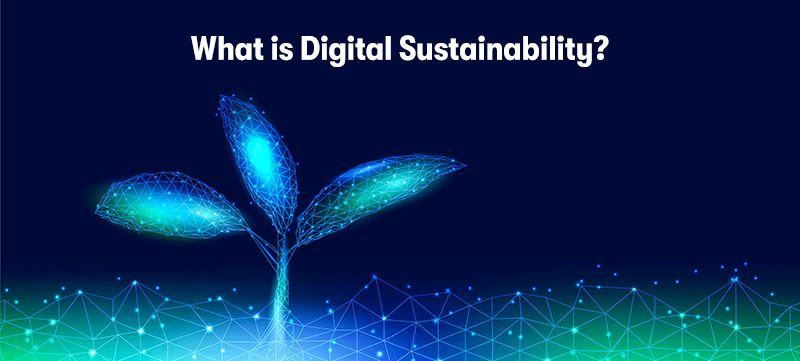
Digital sustainability refers to the responsible and environmentally conscious use of digital technologies, resources, and practices to minimise their negative environmental impact while maximising their positive contributions to sustainability goals. It encompasses a range of strategies and principles aimed at reducing the carbon footprint, energy consumption, and overall environmental impact associated with digital technologies and the digital economy. Key aspects and considerations of digital sustainability include:
Energy Efficiency
Promoting energy-efficient practices in designing, manufacturing, and operating digital devices, data centres, and IT infrastructure. This includes using energy-efficient hardware, optimising software, and adopting energy-saving technologies.
Renewable Energy
Transitioning to renewable energy sources, such as solar, wind, and hydropower, to power data centres and other digital infrastructure. Using clean energy helps reduce greenhouse gas emissions associated with digital operations.
E-Waste Management
Responsible disposal and recycling of electronic waste (e-waste) to minimise the environmental impact of discarded digital devices. This includes recycling electronic components and reducing the use of hazardous materials in device manufacturing.
Circular Economy
Encouraging a circular economy approach for digital products and services, where resources are reused, refurbished, or recycled to extend their lifecycle, reducing the need for new materials and reducing waste.
Data Centre Efficiency
Implementing energy-efficient cooling and data centre designs and optimising server utilisation to reduce energy consumption and environmental impact.
Green Software Development
Promoting sustainable software development practices, including optimising code for efficiency, reducing resource-intensive processes, and using efficient algorithms to minimise energy consumption.
Smart Infrastructure
Developing and implementing digital solutions that improve resource management and reduce waste, such as smart grids, smart transportation systems, and intelligent building management systems.
Telecommuting and Remote Work
Encouraging remote work and telecommuting options to reduce commuting-related carbon emissions and office energy consumption.
Digital Education
Promoting awareness and education about digital sustainability principles and practices among individuals, businesses, and organisations.
Carbon Offset
Compensating for the carbon emissions produced by digital activities through initiatives like carbon offset programs or investments in reforestation and renewable energy projects.
Digital sustainability is becoming increasingly important as the digital economy expands and the environmental impact of digital technologies grows. Businesses and organisations are recognising the need to incorporate sustainability into their digital strategies to mitigate the ecological consequences of their operations. Governments and regulatory bodies are also introducing policies and standards to encourage and enforce digital sustainability practices, driving the adoption of environmentally responsible digital technologies.
Where Can You Learn More About Digital Sustainability?
At Purple Griffon, we offer an ITIL® 4 Specialist Sustainability in Digital & IT (SDIT) training course. This course will help you to:
- Understand how to use the ITIL guiding principles to deliver value by creating sustainable digitally enabled products and services.
- Effectively address VUCA challenges through sustainable strategies, procurement, products and practices.
- Obtain a practical grounding in the key principles of sustainability.
- Conduct a complete cost-benefit analysis identifying potential risks and opportunities using best practice guidance.
Final Notes on Stakeholder Mapping
In this comprehensive exploration of stakeholder mapping and digital sustainability, we've delved into two critical aspects of contemporary business and environmental responsibility.
Stakeholder mapping, as elucidated, is an essential tool for businesses and organisations. It aids in identifying, categorising, and prioritising stakeholders, facilitating effective engagement and risk mitigation. By understanding the interests and influence of key players, organisations can tailor strategies and communications to align with stakeholder expectations, fostering positive relationships and enhancing project and organisational success.
On the other front, digital sustainability underscores the importance of responsible digital technology use. It involves energy-efficient practices, renewable energy adoption, e-waste management, circular economy principles, and more to reduce the environmental impact of the digital economy.
As the world increasingly integrates technology and focuses on sustainability, mastering stakeholder mapping and embracing digital sustainability practices will be crucial for businesses looking to thrive in a responsible and environmentally conscious future.


